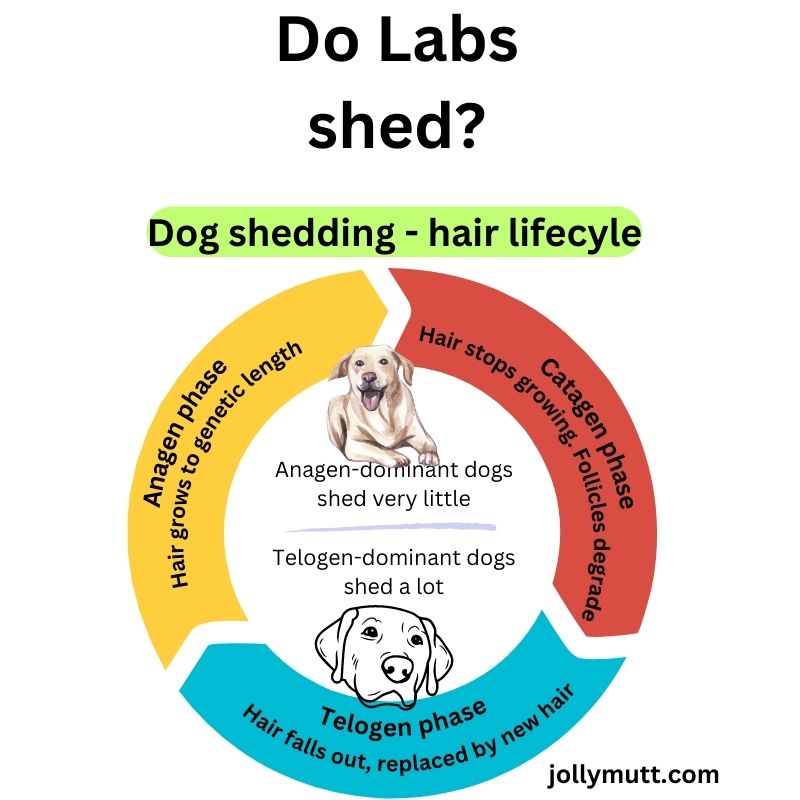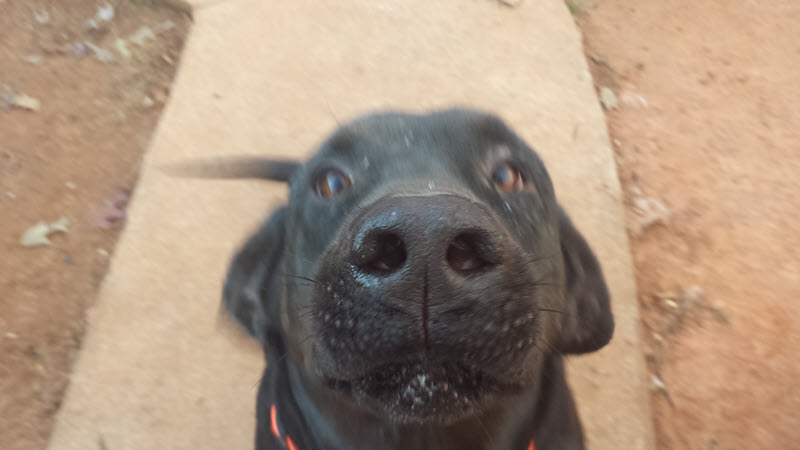You want to know do Labs shed and, if so, how much? Short answer – yes, Labs shed. They shed a lot!
But, as always, there is more to it than the short answer, so read on to find out more.
To understand why Labs shed so much, it’s important to dig into the science of shedding. We won’t go far, just enough to help us understand our pooches.
Why do dogs shed?
Your dog’s coat – explained
A dog’s coat will be (for the most part) single or double-layer. Double-layer coats, or 2-layer coats, consist of an undercoat and an overcoat.
It’s interesting to note that, technically, some dogs have hair while others have fur. And since we’re making generalizations, dogs with fur shed faster than dogs with hair. Dogs with hair have a likelier chance of being hypoallergenic, even though the fur or hair is not a factor here (but rather the dander produced).
To keep this simple, I will refer to it as “hair” throughout this article unless the difference is meaningful in what is being discussed.
The interesting lifecycle of a dog hair
Each dog’s hair grows differently, and, importantly, some dogs have continuously growing hair, and others have hair with shorter lifespans. The longer the lifespan of the hair, the less shedding (normally). A Poodle, for instance, has hair that continuously grows and never sheds. There are reports of Poodles with the same strands of hair upwards of 4+ years.
There are well-defined phases in the lifecycle of hair growth if you can believe it:
- Anagen phase – hair is actively growing and will continue to grow until it reaches its genetically programmed length. There is no end length in some dogs, such as Poodles, so the hair can conceivably continue growing.
- Catagen phase – hair has stopped growing, and the follicle experiences degenerative effects.
- Telogen phase – hair falls out and is replaced by new hair; technically speaking, the telogen hair falls out and is replaced by anagen hair.

Labs are a telogen-dominant breed, meaning – mostly – their hair is always falling out. Contrast that to an anagen-dominated breed such as a poodle whose hair is always growing, and you can see the stark difference between a dog that sheds a lot (Lab) and a dog that sheds very little (Poodle).
By the way, all dogs shed, even Poodles. They just shed less. Even “hairless” dogs, such as the Xoloitzcuintli (Mexican Hairless Dog) or the Peruvian Inca Orchid breed, still have some hair and still shed.
So do Labs have hair or fur?
Labs have fur.
They actually have a double coat they shed twice each year.
So lots of fur to vacuum up!
This double coat makes them practically waterproof, by the way, and it’s the reason Labs are so comfortable in cold water.
Does the weather or season affect how much a dog sheds?
We are all familiar with dogs shedding hair as the weather warms up. We have a red dog, and to this day, we still don’t know what she is. Every year she loses large splotches of her hair, and she looks terrible.
Off to the groomer she goes, or my wife breaks out the clippers.
As summer ends, her coat tends to fill in thicker again, getting her ready for winter.
Interestingly, this has less to do with the temperature changes and more to do with daylight. Shorter daylight indicates it’s time to thicken up the fur, even in climates where it doesn’t necessarily mean it’s going to be cold.
For the true geeks out there, it’s called the photoperiod and refers to the number of light hours in the day and it doesn’t matter if that light is natural or artificial.
We consider this seasonal shedding, and most dogs do at least some. The more hair they have, the more noticeable it is, but even dogs with relatively thin coats of hair (looking at you, Labs!) will still do this, but it may not be as noticeable on the dog itself.
Dogs also shed to get rid of damaged hair. Think of us and our skin.
We also replace our skin regularly, although we don’t notice it. It’s a way to remove old skin, scars, etc.
Dog hair is the same way. It gets old and needs to be replaced. Nature takes care of that for them (and for us!).
Your dog’s diet can also affect how much they shed.
If their diet consists of good, healthy choices, their coat will reflect their health and must be replaced less often.
When a dog’s diet is unhealthy, its hair isn’t healthy so it will shed more.
You’ll notice this on stray dogs who have not been eating well and may be sick.

What to know about Labs and shedding
The Lab’s coat – explained
If you’ve looked around our site a bit, you’ll see we have been rescuing dogs for over 20 years now and have had the pleasure of sharing our house with several Labradors.
And they always shed.
A lot.
Now that we understand the lifecycle of hair, I tend to think of the Lab anagen phase as being measured in minutes. That’s how much they shed.
Did I mention they shed a lot?
Because they do
You’ll read in some places that Labs don’t shed very much. I don’t care if they are shedding hair, fur, or carrots…they shed a lot.
Labs shed constantly, year-round, although it will increase when the hours of the day get shorter.
Their hair is short, however, so less noticeable. You won’t see long strands of hair as you would with a collie. So the individual hairs are less noticeable, but they are there.
…and they’ll pile up!
How much do Labs shed on average
As mentioned, we’ve had Labs for many years. Multiple Labs for many years. So we’ve had the chance to go through the shedding cycle many times.
I can say with absolute certainty that a 60-pound Lab will shed approximately 4,500 pounds of hair each month.
Just kidding, of course.
It just feels that way when you sweep the floor.
There’s no way to measure “how much” a Lab, or any dog really, actually sheds. The hair will fall off inside the house, outside the house, in the car, in the bathtub, or anywhere else, so measuring it would be near impossible.
What is important is to notice if your dog is shedding too much, and “too much” can really only be defined as “more than normal” for your dog.
Over time you will get in tune with the shedding cycles so if something is off, you’ll notice.
Splotches of bald spots or an uneven look to your dog’s coat may indicate an unusual amount of shedding, which can be the result of fleas, stress, sicknesses such as mange, skin infections, and even sunburn.
So spend time noticing, if you will, how much Fido sheds normally so you can pick up on when things aren’t normal.
Grooming tips for Labs
Not much to say here other than bathe and brush regularly.
Brushing regularly is the single best defense against having a house full of loose Lab hair lying around.
In the summer months, our pups spend a lot of time beating each other up in the yard, so we hose them down pretty frequently. Brushing at this time is a welcome treat for them. We have quite a few brushes around here, but the two we use the most are Pet Grooming Gloves (good for cats and dogs) and the HOP Short Hair Dog Brush. I prefer the glove approach as it lets me bond with the pups better, but I do believe the HOP short hair brush is more effective. The silicon side of the brush is kind of like a hair squeegee, if you can imagine.
As the weather cools off, the baths are done inside about once a month. Lord knows sometimes it stretches out more than a month sometimes, but we try!
One of the best “anti-shed” shampoos you can buy is TropiClean Lime & Coconut Deshedding Dog Shampoo for Shedding Control – great shampoo, hugely popular with great reviews, and is safe and effective on dogs and cats.
Any bath is followed by brushing, but we also brush pretty regularly between baths.
How to reduce the amount of shedding from your Lab
Thank you for asking how to reduce, rather than how to stop the shedding.
Dogs have been shedding their hair and fur for thousands of years, so we aren’t likely to stop that anytime soon. In fact, any characteristic with that much momentum will be difficult to alter in any meaningful way, meaning even slowing it down is tough.
There are certain foods you can buy that are purported to slow the process, but, again, you are fighting against thousands of years of evolution. Look for foods or treats with Omega-3 shedding supplements if you want to give this a go. Just keep in mind that it won’t stop shedding, but it can help keep your dog’s skin and hair to the point where it sheds less.
We do two things to help in this respect.
- First, keep the dogs healthy. A healthy dog will shed less. You see strays and feral dogs with bad-looking coats. Healthy dogs have nice coats, and they won’t shed as much.
- Secondly, give up the fight and just enjoy the dog. If nothing else, it gives you a great excuse to spend some time brushing your pooch, which you and the pooch will both love
FAQ
Hair vs. fur
Fur and hair are made up of the same exact protein, keratin, which makes them scientifically identical. Incidentally, this is not just found in dogs – it is the same protein found in human hair (and skin and nails).
How to deal with excess fur and pet mess around the house
Once the mess is in the house, it’s the same as dirt or anything else your dogs are tracking in, so dealing with it is the same. Sweep it up, vacuum, etc.
What I would say here is the best offense is a good defense. Do what you can to prevent the hair from accumulating in the first place, and the two basic things here are frequent brushing and ensuring your dog is healthy
What does blowing coat mean?
This is also called “seasonal shedding,” which is pretty easy to interpret. When “blowing coat,” your dog is shedding his or her winter coat in preparation for summer. Depending on the breed, this can result in much more hair falling out than normal (undercoat and overcoat).
What makes some dogs hypoallergenic?
The issue of hair vs. fur doesn’t come into play as to whether a dog is hypoallergenic. Hair and fur are made of the exact same thing – scientifically, they are identical. What comes into play is the dander, or dead skin (mostly) held by the hair or fur. Fur tends to hold more dander than hair.
What are other heavy-shedding dogs?
We’ve written articles about Pitbulls shedding and Rottweilers shedding, both of which we consider dogs that shed a good bit. We’ll be adding more as time goes on.
Conclusion – do Labs shed (and how much?)
Do Labs shed? Yep, they sure do. How much? Quite a bit, in my opinion, although others seem to disagree. It’s not impossible that some Labs shed more than others, and maybe I’ve just had heavy shedders of the past 25 years. Dunno – in my experience, though, they shed a good bit.
But, they are worth every loose hair you are forced to sweep up. There’s a reason they are one of the most popular dogs around – they are wonderful!
